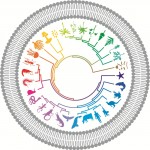 Songs of seduction deconstructed
Songs of seduction deconstructed
For most of us, birdsong is charming, or perhaps an annoying wake-up call; for neuroscientists, it is also an important model system for complex learned behaviours. The behaviours are reasonably accessible to study, but true understanding will require a knowledge of the underlying biomechanics, and this in turn requires a very detailed description of the vocal organ. To this end, using state-of-the-art scanning techniques, Coen Elemans and colleagues have reconstructed the zebra finch vocal organ (the syrinx) in three dimensions, showing its remarkable complexity, which you can admire for yourself as an interactive 3D model in the manuscript PDF (you’ll need Adobe Acrobat Reader 9 or better). For a brief account of how this has helped to explain the vocal acrobatics of the zebrafinch, see our previous blog.
Fruit flies sing too – by vibrating their wings – to attract females during courtship; to help the genetic and neurobiological analysis of the fruit fly serenade, Arthur and colleagues have constructed and describe a new apparatus for recording and analysing these songs in unprecedented detail. The paper reporting this achievement has been blogged too, and you can read more in our earlier account – or if you’d like to build such an apparatus yourself, you will find clear and detailed instructions in the paper!
Saving muscles from disuse
Irregular gym-bunnies will know that it doesn’t take too long without exercise for muscles to begin to waste – but while in this case it’s fairly benign, muscle wasting can be serious in medical settings where immobility and lack of exercise are involuntary – in disease or ageing, for example. Much recent work has focused on understanding at a molecular level the biological signalling pathways that lead to muscle atrophy – the hope obviously being that this may eventually lead to ways of treating it.
In a recent attempt to find factors in muscle wasting that might be susceptible to intervention, Wei et al. have identified a kinase (MST1) that is up-regulated on muscle denervation in wild-type mice, while mice without a working copy of MST1 are protected from the muscle wasting that normally follows loss of their nerve supply. MST1 acts through activation and nuclear translocation of the transcription factor FOXO – but only in fast-twitch muscle, and not the slow-twitch fibers that are responsible for sustained contraction. Not an immediate answer to muscle atrophy, but a step on the path to progress.
Climate change and shifting seaweed
Changes in climate have been shown to have an effect on a number of species’ geographical ranges, with the usual effect of warming being to push a species’ range towards the colder polar regions. While it’s easy to make the mistake of imagining whole populations shifting their ranges as individuals – like migrating birds fleeing the European winter – it’s important to remember that a population shift usually represents something more akin to an imbalance of births and deaths in different areas, plus a slow expansion into newly habitable regions.
It’s in this light that a new study of seaweed populations along the Atlantic coast is important, as it shows that this pattern of births and deaths can be seriously detrimental when a population is divided into – perhaps cryptic – subpopulations. The range of this particular seaweed has been moving northwards recently, and a genetic analysis of microsatellites reveals that there are two distinguishable subpopulations – and because the southern subpopulation is taking the brunt of the effect of the warming sea, it is in danger of going extinct. This would obviously result in a significant loss of genetic diversity, and this kind of substructuring will need to be explicitly taken into account before we declare a population is fully able to adapt to changing climate.
Kester Jarvis
Latest posts by Kester Jarvis (see all)
- The agony of choice: conservation biology and choosing what to save - 18th March 2014
- Sigma factor networking and bacterial versatility - 30th January 2014
- Electricity generation and fish populations: how a power station provided a rich biological dataset - 4th September 2013
Comments